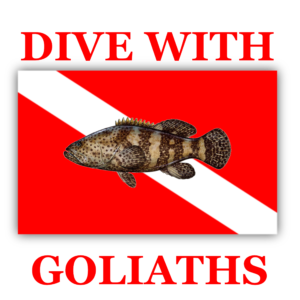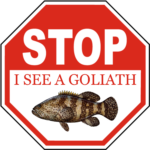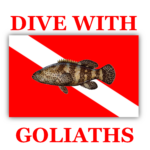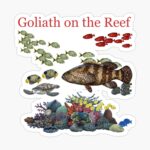At its May meeting, the Florida Fish and Wildlife Conservation Commission (FWC) listened to a presentation and stakeholder input on goliath grouper in Florida state waters. The Commission directed staff to continue ongoing efforts that recognize the goliath’s role in the ecosystem and promote stock rebuilding while allowing access to goliath through catch-and-release, ecotourism, and dive viewing opportunities.
They also directed staff to develop a proposed draft rule for consideration by the Commission at a future meeting that would build on existing access opportunities for goliath by considering a limited, highly regulated harvest.
 “We should applaud our successes,” said FWC Chairman Rodney Barreto. “I’m in favor of coming back with a very delineated list of line items for a limited take that wouldn’t disturb the dive industry and would provide additional access to this fishery. Just because we’ve been doing something for 30 years doesn’t mean we need to keep doing it the same way.”
“We should applaud our successes,” said FWC Chairman Rodney Barreto. “I’m in favor of coming back with a very delineated list of line items for a limited take that wouldn’t disturb the dive industry and would provide additional access to this fishery. Just because we’ve been doing something for 30 years doesn’t mean we need to keep doing it the same way.”
“I’m not suggesting we do this at the end of the day but I am saying we should direct staff today to move forward, continue to gather input on this, and see if we can’t come up with a win-win for all stakeholder groups,” said FWC Commissioner Robert Spottswood.
The FWC will continue to monitor the status of the stock using alternative metrics approved by the Commission in 2018.
Learn more about goliath grouper at MyFWC.com/Marine by clicking on “Recreational Regulations” and “Goliath Grouper” under the “Reef Fish” tab.
View the Commission meeting presentation at MyFWC.com/Commission by clicking on “Commission Meetings” and the agenda under “May 12-13, 2021.”
Goliath Grouper
The giant of the grouper family, the goliath (formerly called jewfish) has brown or yellow mottling with small black spots on the head and fins, a large mouth with jawbones that extend well past its small eyes, and a rounded tail. It also has five dark body bands or stripes that are most visible on young goliath.
What to do when you’ve caught a goliath grouper?
Harvest and possession has been prohibited in both state and federal waters off Florida since 1990.
- Must be immediately returned to the water free, alive and unharmed.
- Photographs can be taken but only during the active act of release. Photographs or any other activities such as measuring the fish should not delay release in any way.
- Large goliath groupers should be left in the water during release. The skeletal structure of large goliath grouper cannot adequately support their weight out of the water without some type of damage. If a large goliath is brought on-board a vessel or out of the water, it is likely to sustain some form of internal injury and therefore be considered harvested.
- Removing smaller goliath groupers from the water to remove hooks is not necessarily a bad practice, but this process must be done with care, using proper fish handling techniques, and the fish must be returned to the water as expeditiously as possible.
- Learn more about Fish Handling and maximizing fish survival when practicing catch and release.
- Can I feed sharks and other fish like goliath grouper?
Goliath grouper is the largest of the Atlantic groupers. This giant can reach 800 pounds (455 kg) and over 8 feet (2 meters) in length. The Florida record is a 680-pound goliath grouper caught off Fernandina Beach in 1961. The species had been targeted both commercially and recreationally since at least the late 1800s.
There are a number of factors that contributed to the decline of goliath grouper, included declines in juvenile habitats, strong site fidelity, and being long lived. Goliath form large aggregations and these often occur in areas where fishermen congregate. Goliath are also susceptible to large-scale mortality events such as cold temperatures and red tide blooms.
When not feeding or spawning, adult goliath groupers are generally solitary, sedentary, and territorial. Before the goliath grouper reaches full-size it is preyed upon by barracuda, king mackerel and moray eels, as well as sandbar and hammerhead sharks. Once fully grown, humans and large sharks are the goliath grouper’s only predators.
Goliath grouper were historically found in tropical and subtropical waters of the Atlantic Ocean, both coasts of Florida and from the Gulf of Mexico down to the coasts of Brazil and the Caribbean.
In waters off Florida, young goliath grouper spend up to 5-6 years in mangrove habitat, particularly in the Ten Thousand Islands area off southwest Florida, which seems to be its center of abundance and may serve as critical nursery habitat. As they grow, goliath grouper move to shallow reefs, eventually joining adult populations offshore on shallow artificial and natural reefs. Adults seem to prefer habitat with overhangs, bridges, piers, and shipwrecks.
Goliath grouper are opportunistic predators and feed mostly on slow-moving, bottom-associated species. Calico crabs make up the majority of their diet, with other invertebrate species and fish filling in the rest. Goliath grouper will occasionally feed on fish that are struggling on a fishing line, but they have not been shown to actively hunt down fast, free-swimming fish such as snappers and groupers. Prey is ambushed, caught by a rapid expansion and opening of the mouth that allows prey to be sucked in and swallowed whole.
Goliath grouper are relatively long-lived, with a maximum known age to be at least 37 years old. However, some scientists estimate that these fish may have the ability to live over 50 or even 100 years. Reproductive maturity first occurs in fish 5 or 6 years of age (about 36 inches in length) due to their slow growth rate. Males mature at a smaller size (about 42 inches) and slightly younger age than females. Females first mature at 6-7 years of age and 47-53 inches in length. In the eastern Gulf, goliath grouper have been known to form spawning groups of 100 individuals or more. These groups occur at consistent sites such as wrecks, rock ledges, and isolated patch reefs during July, August, and September. Studies have shown fish may move up to 62 miles (100 km) from inshore reefs to these spawning sites. In southwest Florida, presumed courtship behavior has been observed during the full moons in August and September.
Population Assessment
Alternative management goals and metrics were adopted in 2018 to evaluate the stock through ongoing research. These goals and metrics provide a way to assess goliath without conducting a full-scale traditional fisheries stock assessment.
Because goliath is not suited to traditional fisheries stock assessments FWC uses five metrics to benchmark goliath’s performance against five management goals (see table below).
You can find these designs and many more on products such as t-shirts, mugs, phone cases, stickers, magnets, and hoodies at KeysTreasures.RedBubble.com



